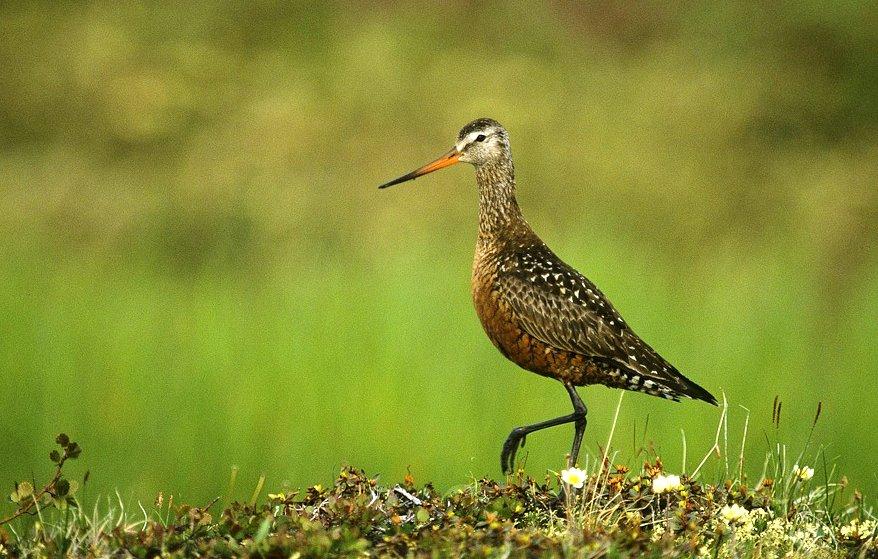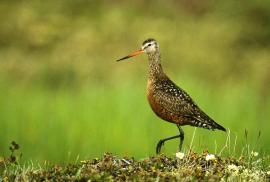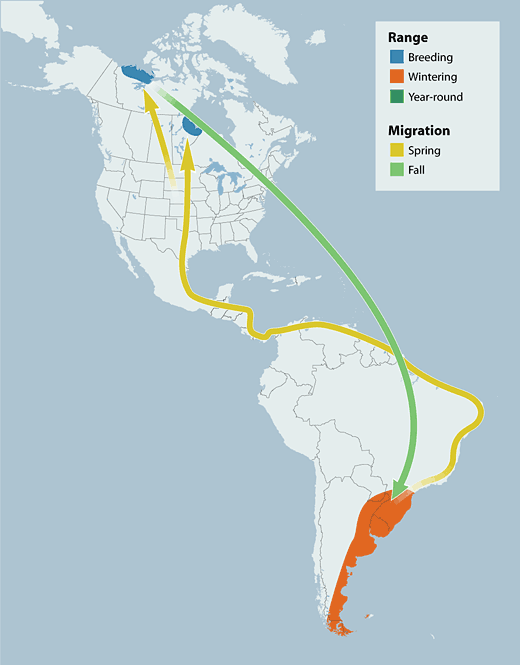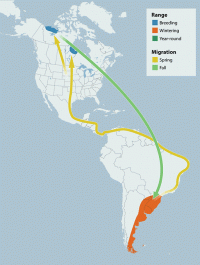Guide to Boreal Birds
This is an in-depth boreal species profile.
What is this?
This species is one of more than 30 birds selected for in-depth profiles. Find out why and see all selected boreal birds »
Overview
Field ornithology instructors often advise their students to remember that godwits' bills curve upwards "towards God" as a way of distinguishing godwits from other large, long-billed shorebirds. The origin of the word 'godwit' is unknown; this species received its English name from its primary known breeding grounds and its Latin name from the reddish color of its breeding plumage. It is the smallest and least known of the world's four godwit species. It once was regarded as one of North America's rarest birds; though it is now known to be much more numerous, it is still considered highly vulnerable because its population is concentrated at only a few sites.
Never common, the Hudsonian Godwit was for many years hunted for food and became scarce. Now completely protected, it has increased in number considerably. It is still considered a rarity, however, because during migration to and from the Southern Hemisphere the Hudsonian Godwit engages in long flights, traveling nonstop between James Bay, Canada, and the Gulf Coast, and thus bypassing most birders. On the coastal mudflats of the northeastern states, this large shorebird can be seen in flocks of up to several dozen during fall passage.
Description
15" (38 cm). A large slender shorebird with a long, slightly upturned bill. Breeding adult has barred chestnut underparts, mottled brown upperparts. Fall birds grayish above, whitish below. All plumages have black and white tail, broad white wing stripe, and black wing linings.
Voice
A loud kerreck or god-wit call, similar to call of Marbled Godwit but higher pitched. Usually silent.
Nesting
4 olive-buff eggs, spotted with brown and black, in a shallow grass-lined hollow on the ground.
Habitat
The nesting habitat of the Hudsonian Godwit is fairly typical of boreal shorebirds. In most locations, it nests in areas of mixed forest and wetland, particularly sedge meadows and boggy muskeg surrounded by coniferous forest. Scattered trees, small ponds, hummocks, and wet meadows are usually present. Occasionally, it nests in dwarf shrub meadows and some distance from water. Coastal populations commute daily to forage in salt marshes and on tidal mudflats. At other times of the year, Hudsonian Godwits use a wide variety of wetland and some upland habitats, including estuaries, mudflats, fresh and salt marshes, lakes, sandy beaches, wet rice fields, sewage lagoons, salt ponds, mangrove swamps, and sand spits. The bulk of the population feeds on tidal mudflats of large bays in winter, roosting on small islands and floating vegetation and in grassy fields.
Range/Migration
Migration patterns of this species are complex and poorly known, the little information available having been pieced together from observations of birds on a few staging grounds. Western breeders congregate in coastal habitats following nesting, beginning with males in late June, joined by females and young in July and August. They depart in August (adults first) and apparently travel to lakes in southern Saskatchewan to rest and refuel. It is unknown what route they take from there to their winter grounds in southeastern South America. Nearly 9,000 individuals, presumably from the Churchill population, have been recorded on the Pen Islands, Ontario. Most Canadian breeders congregate on the southern shores of James Bay, with smaller numbers in the Gulf of St. Lawrence and at the Bay of Fundy, in late July and depart in August; their young congregate in August and depart in September and October. Most of these birds apparently fly at least 4,500 km (about 2,800 miles) nonstop over the Maritimes and New England and then over the Atlantic to South America, though small numbers appear at inland sites in the Northeast U.S. and along the coast south to Delaware Bay, especially in association with strong northeasterly winds. Once they reach South America, they apparently travel mostly through the interior at least as far as Paraguay and southern Brazil; most go all the way to Tierra del Fuego, where the bulk of the species winters at only two sites, one in Argentina, the other in Chile. Spring migration begins in early March and primarily follows the Atlantic, Caribbean, and Gulf coasts. After arriving on the Texas coast in late March and April, birds cross the Great Plains, staging at Cheyenne Bottoms in Kansas and Lake Thompson in South Dakota and finally reaching the breeding grounds between late April and early June. Some nonbreeders move to northern Argentina for the austral winter.
Breeding
The breeding range of the Hudsonian Godwit is perhaps best described as enigmatic. Known breeding sites are widely scattered across boreal and arctic North America, including Kotzebue and Nome Sounds, the Yukon and Kuskokwim Rivers, and Cook Inlet in Alaska; Chilkat Pass in British Columbia; the Churchill delta in Manitoba; the western Hudson Bay coast in Ontario; and the Mackenzie and Anderson deltas and Great Slave Lake in the Northwest Territories. Numerous sightings of birds elsewhere in Alaska and Canada during the breeding season, combined with the fact that known nesting areas support only a small portion of the known total population, indicate that most nesting areas remain undiscovered. It is likely that the species nests in small, scattered clusters throughout the vast expanse of suitable habitat in the region and that nesting sites may shift from year to year. It is believed that over 80% of the world's population nests in the boreal region. Breeding populations are quite distinct genetically but show no obvious external differences and only a single subspecies is recognized. Little is known of the species' breeding ecology. Monogamous pairs form on the breeding grounds through a courtship process of display flights. A simple nest depression is formed, probably by the male, in a mound of moss or other soft vegetation on a dry hummock, often under a dwarf birch. Apparently, both sexes incubate the two to four eggs for 31⁄2 weeks. Both parents brood and guard the precocial chicks until they fledge, in just under four weeks.
Diet/Feeding Behavior
The Hudsonian Godwit's dietary habits show some seasonal variation. During most of the year, invertebrates comprise essentially all of the diet. Prey taken include flies, beetles, snails, mollusks, amphipods, crabs, clams, and worms. Crowberries have been reported as a food item on the breeding grounds. During migration, when carbohydrates may be more important than protein, plant tubers, especially those of sago pondweed, represent a significant portion of the diet. Undigested seeds also have been found in the anterior portions of the gastrointestinal tracts of migrating birds; these may have been ingested to help grind other foods in the gizzard. Most food is obtained by probing with the long bill, which can be opened at the tip to grasp food. Gleaning from vegetation, mud, and the water surface is also a frequent means of food acquisition.
References
Alexander, S. A., K. A. Hobson, C. L. Gratto-Trevor, and A. W. Diamond. 1996. Conventional and isotopic determination of shorebird diets at an inland stopover: the importance of invertebrates and Potamogeton pectinatus tubers. Can. J. Zool. 74:1057-1068.
Elphick, C. S., and J. Klima. 2002. Hudsonian Godwit (Limosa haemastica). The Birds of North America, No. 629 (A. Poole and F. Gill, eds.). The Birds of North America, Inc., Philadelphia, PA. Hagar, J. A. 1966. Nesting of Hudsonian Godwit at Churchill, Manitoba. Living Bird 5:5-43.
Haig, S., C. L. Gratto-Trevor, T. D. Mullins, and M. A. Colwell. 1997. Population identification of Western Hemisphere shorebirds throughout the annual cycle. Mol Evol. 6:413-427.
Harrington, B. A., C. Picone, S. Lara Resende, and F. Leeuwenberg. 1993. Hudsonian Godwit Limosa haemastica migration in southern Argentina. Wader Study Group Bull. 67:41-44.
McCaffery, B. J., and C. M. Harwood. 2000. Status of Hudsonian Godwits on the Yukon-Kuskokwim Delta, Alaska. West. Birds 31:165-177.
Swallow, J. 1994. Hudsonian Godwit migration: a comment. Wader Study Group Bull. 72:31.
Williamson, F. S. L., and M. A. Smith. 1964. The distribution and breeding status of the Hudsonian Godwit in Alaska. Condor 66:41-50.
Credits
Birding content provided by National Wildlife Federation/eNature, with support from Ducks Unlimited/The Pew Charitable Trusts.





